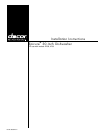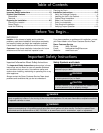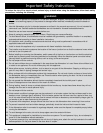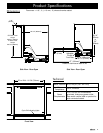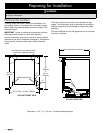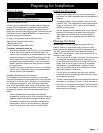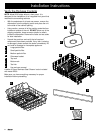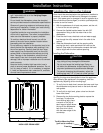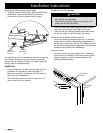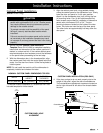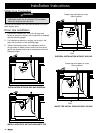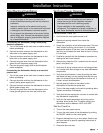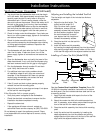
5
Power Supply
WARNING
The electrical power supply for the dishwasher should
be installed only by a licensed electrician.
Electrical Specifications
It is the owner’s responsibility to ensure that the electrical
connection of this appliance is performed by a qualified
electrician. The electrical installation, including minimum
supply wire size and grounding, must be in accordance with
the National Electric code ANSI/NFPA* (or latest revision)
and local codes and ordinances.
*A copy of this standard may be obtained from:
National Fire Protection Association
1 Batterymarch Park
Quincy, Massachusetts 02269-9101
The power connection must be:
A grounded, dedicated 120 Vac, 60 Hz circuit protected
by a 15 amp circuit breaker or time delay fuse. The
circuit must be installed by a licensed electrician. Local
codes may permit a UL listed/CSA-certified, grounded
power supply cord (not provided) for connection to a
grounded three prong receptacle, or an armored non-
metallic sheathed, copper wire with ground to connect
to a junction box.
Located to the right or left of the cut-out, in an adjacent
cabinet, so that the power cable can be disconnected
without removing the dishwasher.
Installing the Electrical Connection
The dishwasher can either be connected to a grounded
three prong receptacle or connected directly to a three wire
connection in a junction box. If the unit is to be connected
to a three prong receptacle, a UL/CSA approved power
cord, of the appropriate power rating (not provided), must
be connected to the dishwasher electrical wiring. Consult
all governing codes to determine the appropriate type of
wiring.
Have a licensed electrician prepare the electrical
receptacle or junction box for final connection inside the
adjacent cabinet according to the specifications above.
The electrical power source must be a metal ground
wiring system, which is not connected to a gas pipe.
Do not install a fuse in the neutral or ground circuit.
•
•
•
•
Install the Plumbing
Install a water supply valve for the hot water supply
line where it is easily accessible after the dishwasher is
installed.
The water pressure must be between 20 and 120 psi
(138-827 kPa). The household hot water heater should
supply a minimum of 120°F water to the dishwasher
location for best results.
Use the supplied flexible braided water line to connect
between the dishwasher hot water inlet and the hot
water supply valve. Make sure it is long enough to
reach when the unit is removed from the cabinet for
repair.
Planning the Drain
IMPORTANT: A drain line hose is supplied with the
product. Should a longer drain hose be required, use a
hose approved for detergents and high temperature water.
The drain hose supplied with the dishwasher meets an
AHAM DW-1 test standard. Longer drain hoses should not
exceed 12 feet in length.
You must install an air gap in the drain if the drain hose
is connected to household plumbing lower than 20
inches (508 mm) from the floor or if required by local
codes. Plan for the air gap in the sink or countertop
area adjacent to the dishwasher. A section of drain
hose (not provided) needs to be installed from the air
gap to the disposal or waste tee.
If an air gap is not required, the drain hose must be
installed to an inlet or waste tee above the drain trap in
the household plumbing.
The drain hose supplied with the dishwasher should be
connected to a minimum 1/2 inch I.D. drain connection.
If the drain is connected to a disposal, see the disposal
manufacturer’s installation instructions for correct drain
hose mounting techniques.
•
•
•
•
•
•
•
Preparing for Installation



